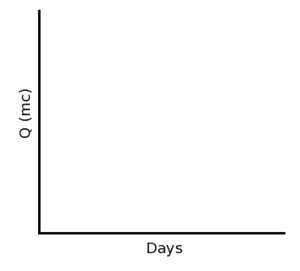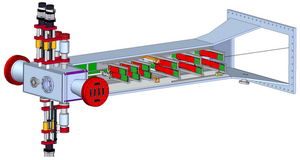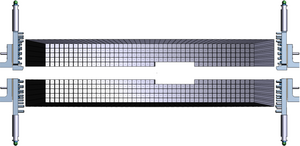Difference between revisions of "The HPS Run Wiki"
| Line 175: | Line 175: | ||
'''If you change beam current current, turn orbit locks off first''', there is a current - position dependence on the stripline BPMs 2H00 and 2H02. | '''If you change beam current current, turn orbit locks off first''', there is a current - position dependence on the stripline BPMs 2H00 and 2H02. | ||
'''Do NOT change magnet currents when beam is on.''' | '''Do NOT change magnet currents when beam is on.''' | ||
| + | |||
| + | * If Omar and beamline expert are available during day or swing, do SVT Wire Scan. This still needs an expert. Orbit locks must be temporarily removed to move beam horizontally with upstream correctors, if needed. Restore orbit locks when done. | ||
| + | |||
| + | '''<font size=3> Subsystem Commissioning Studies. Begin Data Taking.</font>''' | ||
<font color='red'> DO NOT RUN MORE THAN 30 MINUTES ABOVE 50 nA WITHOUT THE BEAM BLOCKER</font><br> | <font color='red'> DO NOT RUN MORE THAN 30 MINUTES ABOVE 50 nA WITHOUT THE BEAM BLOCKER</font><br> | ||
<font color='red'> PUT BEAM BLOCKER IN FOR LONG RUNNING AT HIGH CURRENT</font><br> | <font color='red'> PUT BEAM BLOCKER IN FOR LONG RUNNING AT HIGH CURRENT</font><br> | ||
| + | * Make sure DAQ is OK for data taking | ||
* More Trigger commissioning data runs. See [[Media:HPS_TriggerCommissioning_March2015.pdf|Valery's note]] on the run Wiki under commissioning trigger. | * More Trigger commissioning data runs. See [[Media:HPS_TriggerCommissioning_March2015.pdf|Valery's note]] on the run Wiki under commissioning trigger. | ||
* If orbit locks are on, call Rafayel for beam trip study. Take 4 hours of beam trip data with wire up; take 4 hours of beam trip data with wire down. | * If orbit locks are on, call Rafayel for beam trip study. Take 4 hours of beam trip data with wire up; take 4 hours of beam trip data with wire down. | ||
| − | * Absent other requests, take data at | + | * Absent other requests, take data at 50 nA. Be sure to block Faraday cup if higher current. |
| + | |||
| + | |||
| + | {| | ||
| + | | valign=top | | ||
| + | |||
| + | {| class=wikitable style="text-align:center; margin:auto" width=200 | ||
| + | !colspan=2 style="background:#ffdead;" | Beam | ||
| + | |- | ||
| + | | Energy || ~2.0 GeV | ||
| + | |- | ||
| + | | Current || < 200.0 nA CW | ||
| + | |- | ||
| + | |colspan=2 style="background:#e0e0e0;" | Position | ||
| + | |- | ||
| + | | X || Y | ||
| + | |- | ||
| + | | ~0 mm || ~0 mm | ||
| + | |- | ||
| + | |colspan=2 style="background:#e0e0e0;" | Profile | ||
| + | |- | ||
| + | | X || Y | ||
| + | |- | ||
| + | | < 0.1 mm || < 0.1 mm | ||
| + | |} | ||
| + | |||
| + | {| class=wikitable style="text-align:center; margin:auto" width=200 | ||
| + | !colspan=2 style="background:#ffdead;"| Target | ||
| + | |- | ||
| + | | #1 || 0 mm | ||
| + | |} | ||
| + | |||
| + | {| class=wikitable style="text-align:center; margin:auto;" width=200 | ||
| + | !colspan=2 style="background:#ffdead;"| Magnets | ||
| + | |- | ||
| + | | PS Current || 0 A | ||
| + | |- | ||
| + | | Chicane Dipole #1 || 0 A | ||
| + | |- | ||
| + | | Chicane Dipole #2 || 0 A | ||
| + | |} | ||
| + | |||
| + | | valign="top" | | ||
| + | |||
| + | {| class=wikitable style="text-align:center; margin:auto;" width=400 | ||
| + | !colspan=2 style="background:#ffdead;"| DAQ | ||
| + | |- | ||
| + | |Configuration || ___________________ | ||
| + | |- | ||
| + | |Configuration file || | ||
| + | |- | ||
| + | |Prescales || | ||
| + | |- | ||
| + | |Thresholds || | ||
| + | |- | ||
| + | |Events Per Run || | ||
| + | |- | ||
| + | |Dead Time || | ||
| + | |} | ||
| + | |||
| + | |||
| + | |||
| + | |} | ||
| + | |||
| + | |||
| + | |} | ||
| + | |||
| + | |||
| + | {| class=wikitable style="text-align:center; margin:auto;" width=600 | ||
| + | !colspan=4 style="background:#c06c60;"| Trigger | ||
| + | |- | ||
| + | !colspan=2 style="background:#ffdead;" | FADC || colspan=2 style="background:#ffdead;" | GTP | ||
| + | |- | ||
| + | |NSB/NSA || 20/100 ns || Samples Before/After || 3/3 | ||
| + | |- | ||
| + | |Readout Threshold || 12 ADC || Seed Threshold || 80 MeV | ||
| + | |- | ||
| + | !colspan=4 style="background:#ffdead;" | SSP | ||
| + | |- | ||
| + | !colspan=2 | || style="background:#87d7d7;" | Singles-0 || !colspan=2 style="background:#87d7d7;" | Singles-1 | ||
| + | |- | ||
| + | !colspan=2 style="font-weight:normal" | # Hits || >2 || >2 | ||
| + | |- | ||
| + | !colspan=2 | Cluster Energy || 0.1 < E < 2.5 GeV || 0.5 < E < 1.2 GeV | ||
| + | |- | ||
| + | !colspan=2 | || style="background:#87d7d7;" | Pairs-0 || !colspan=2 style="background:#87d7d7;" | Pairs-1 | ||
| + | |- | ||
| + | !colspan=2 | Cluster Energy || 0.09 < E < 1.3 GeV || 0.1 < E < 0.6 GeV | ||
| + | |- | ||
| + | !colspan=2 | Energy Sum || 0.19 GeV < E < 2.2 GeV || 0.21 < E < 1.0 GeV | ||
| + | |- | ||
| + | !colspan=2 | Energy Difference || dE < 1.2 GeV || dE < 0.65 GeV | ||
| + | |- | ||
| + | !colspan=2 | Coplanarity || N/A || Theta < 40 deg | ||
| + | |- | ||
| + | !colspan=2 | Energy Slope || N/A || > 0.6 GeV | ||
| + | |- | ||
| + | !colspan=4 style="background:#ffdead" | TI Prescales | ||
| + | |- | ||
| + | | Singles-0 || Singles-1 || Pairs-0 || Pairs-1 | ||
| + | |- | ||
| + | | 0 || 0 || 0 || 0 | ||
| + | |} | ||
| + | |||
| + | |||
| + | <!--####################################### LONG TERM #################################################--> | ||
| + | <!--####################################### LONG TERM #################################################--> | ||
| + | <!--####################################### LONG TERM #################################################--> | ||
= '''Long Term Schedule''' = | = '''Long Term Schedule''' = | ||
Revision as of 15:48, 25 April 2015
Important Phone NumbersShift ScheduleShift-Taker's ChecklistHot CheckoutBeam Time AccountingHPS Run Spreadsheet |
Procedures
|
Manuals |
JLab Logbooks
|
RC: Raphael Dupre
PDL: Stepan StepanyanEvery Shift:
SVT InstructionsBefore sending beam to Faraday cup, verify (and page SVT expert if otherwise):
The first time sending beam to the Faraday cup after the hall is closed, page the SVT expert.
Acceptable Beam Conditions:To establish good beam conditions first send beam to the tagger dump (ask MCC to turn ON the tagger).
While MCC degausses the tagger magnet, turn the chicane ON
Before sending beam to the Faraday cup
Beam to the Faraday cup
Before accepting beam, make sure all the previous conditions are met. Always read previous log entries, compare settings of BPMs and correctors with previous settings using scaler_hps GUI. Every Run:
Miscellaneous:
|
Run Plan: April 23-30, 2015 (day/swing/owl)During week days, Mon-Thursday, there will be no Day shifts due to work in the hall. Short Term Schedule: Study Trigger and SVT running conditions. We will be running with 1.05GeV beam. This beam needs to be carefully restored, first to the tagger dump, then the alcove and Faraday cup screen. See detailed instructions in the left pannel.
Then, proceed with program Notes: If you change beam current current, turn orbit locks off first, there is a current - position dependence on the stripline BPMs 2H00 and 2H02. Do NOT change magnet currents when beam is on.
Subsystem Commissioning Studies. Begin Data Taking. DO NOT RUN MORE THAN 30 MINUTES ABOVE 50 nA WITHOUT THE BEAM BLOCKER
| ||||||||||||||||||||||||||||||||||||||||||||||
| Trigger | |||
|---|---|---|---|
| FADC | GTP | ||
| NSB/NSA | 20/100 ns | Samples Before/After | 3/3 |
| Readout Threshold | 12 ADC | Seed Threshold | 80 MeV |
| SSP | |||
| Singles-0 | Singles-1 | ||
| # Hits | >2 | >2 | |
| Cluster Energy | 0.1 < E < 2.5 GeV | 0.5 < E < 1.2 GeV | |
| Pairs-0 | Pairs-1 | ||
| Cluster Energy | 0.09 < E < 1.3 GeV | 0.1 < E < 0.6 GeV | |
| Energy Sum | 0.19 GeV < E < 2.2 GeV | 0.21 < E < 1.0 GeV | |
| Energy Difference | dE < 1.2 GeV | dE < 0.65 GeV | |
| Coplanarity | N/A | Theta < 40 deg | |
| Energy Slope | N/A | > 0.6 GeV | |
| TI Prescales | |||
| Singles-0 | Singles-1 | Pairs-0 | Pairs-1 |
| 0 | 0 | 0 | 0 |
|
|
| ||||||||||||||||||||||
|
|
|
| ||||||||||||||||||||||||||||||||||||||||||||||||||||||||
|
Webcams: |
Trigger: |
Accelerator: Slow Controls:
|
Online & Offline: |


